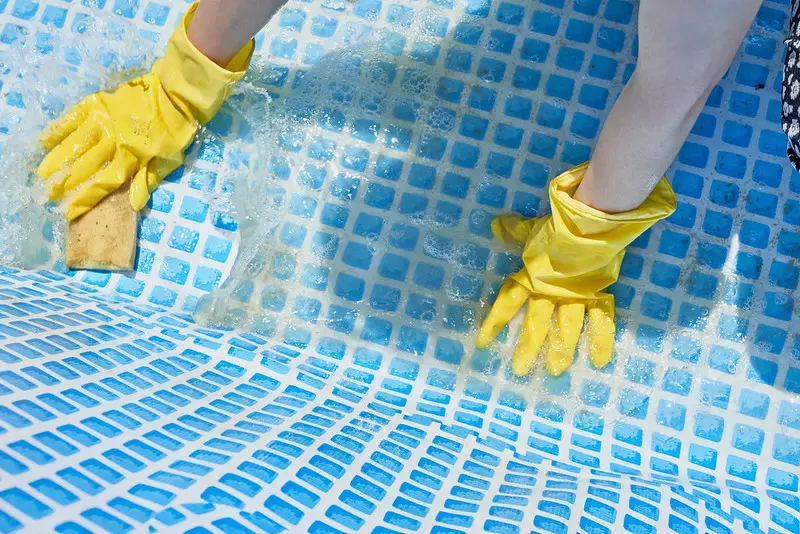If your pool looks relatively clean, but you feel that the pool walls and floor are slippery or slimy then you know something isn’t right. But what could be the cause?
The most common causes of a slippery pool floor and walls are algae, a new pool liner, white water mold, and pink slime. These problems arise when your pool is low on free chlorine, or something is off with your water chemistry. You should use a water test kit and find out what you need to add to balance your pool.
Keep reading on to learn more about each specific problem and how to get rid of them.
What causes your pool walls and floor to be slippery?
Algae
The most likely culprit for slippery pool floors and walls are algae blooms. That said, it is very obvious when your pool has an algae bloom because your pool will be a distinct green color.
This commonly occurs over the winter when most people have closed their pools, and come spring, they uncover their pool to green water.
That said, a developing algae bloom may not necessarily be visible yet but it can already begin to make surfaces slippery.
That is why you must be extremely careful around stairs and ladders because you might accidentally fall while climbing in or out of the pool.
White water mold
White water mold is a type of fungus. You can tell it’s there when your swimming pool looks like it’s sick.
Specifically, it will have a slimy, mucus-like feeling like the water itself has turned into snot. This snot-like substance can cover pool surfaces including the walls and floors of the pool.
If you notice a white substance in your pool, it’s probably white water mold.
Pink slime
If you see orange/pink streaks where the pool’s waterline is, or in corners, light fixtures, pipe fittings, and even the water’s surface, then that’s probably pink slime.
Pink slime is often mistaken for algae, but it’s technically bacteria. You’ve probably also seen it in your bathroom such as along your shower curtain, around the waterline in the toilet bowl, and streaks of it on your bathtub walls.
Another common mistake is assuming that it is rust, and then falsely assuming that you have hard water. It’s not rust; it’s bacteria.
It loves to feast on soap scum and soap/shampoo residue. Seeing pink slime, whether it’s in your bathroom or swimming pool, is a sign that you need to thoroughly clean and disinfect those areas.
A new liner
Unlike the other causes of a slippery pool, this one does not involve any bacteria whatsoever.
Sometimes, if you’ve just recently replaced the pool liner, you may feel that the new liner is very slippery.
This is because additives (known as ‘lubricants’) were added to the liner during manufacturing to help make it more flexible. These additives will sit on the surface and make the liner feel slippery.
The stark contrast between the rougher texture of an old liner and the new liner that replaced it can cause people to think there is a serious problem.
The good news is that this slippery texture is only temporary and will wash off on its own within 6-12 weeks.
How to clean up a slippery pool
All of the possible causes of a slippery pool mentioned above, with the exception of the new pool liner, occur when there is something wrong with the water chemistry which results in lower chlorine levels.
That is why whenever you have something wrong with the pool, one of the first things you should do is test the water to check how the water chemistry is.
Pay particular attention to the chlorine and stabilizer levels, especially after heavy rain or sunny weather.
It’s possible that your pool chemicals were heavily diluted or were burned off by the sun’s harsh UV rays.
If your free chlorine levels are low (below 1-3 ppm), then it’s important to get that corrected ASAP.
Aside from balancing the chemicals, you should also manually brush the walls and floor of your pool to loosen any algae and debris from the liner.
As mentioned, a developing algae bloom may not be fully visible yet, but it’s important that you prevent algae from taking root and spreading.
Once you’ve gotten rid of any slippery feeling from the floor and walls, rinse or backwash your filter to get rid of any algae in the system. Continue brushing the pool, filtering, and adding chemicals as a regular part of pool maintenance.
Why you need to fix these problems immediately
Aside from the fact that algae blooms, white water mold, and pink slime are slipping hazards, their presence on the pool walls, floor, or even the water’s surface can be a health risk.
When your pool is slimy, that means that the disinfecting chemicals you added into the pool aren’t working anymore.
In other words, your pool is being infested with bacteria which is causing your pool to be slimy and slippery all over.
If these bacteria enter your body – typically through the eyes, nose, or an open wound – then they can cause illnesses such as UTIs, pneumonia, lower respiratory tract infections, and so on.
Therefore, unless you want to fall ill and go to the hospital just because you went for a swim, then you need to test your pool more often and make sure the water chemistry is balanced.
Photo Credit: Marco Verch Professional Photographer (CC BY 2.0)

